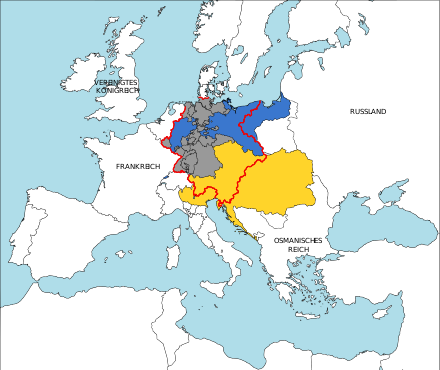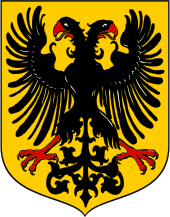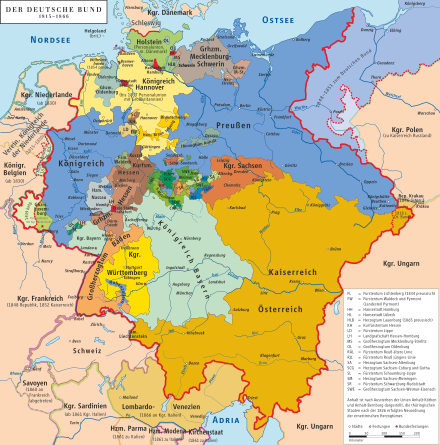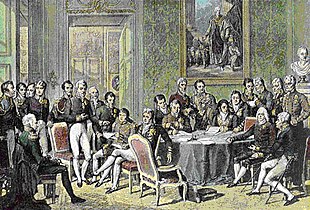German Confederation
![]()
The title of this article is ambiguous. For other meanings, see German Confederation (disambiguation).
The German Confederation was a confederation of states agreed upon in 1815 by the "sovereign princes and free cities of Germany", including the Emperor of Austria and the kings of Prussia, Denmark (with regard to Holstein) and the Netherlands (with regard to Luxembourg). This federation existed from 1815 to 1866 and already had federal features, since a right of the German federation developed, which bound the member states. Nevertheless, the German Confederation did not possess state power, but only an "association competence mediated by international treaty" (Michael Kotulla). According to the preamble of the Act of Confederation, the princes had united to form a "permanent federation", but these are to be seen as representatives of their states. The Confederation had as its task to ensure the internal and external security of the constituent states. Thus, the purpose of the Confederation was much more limited than that of the Holy Roman Empire, which had been dissolved in 1806. This German federation ultimately failed because of the different ideas of state and society, but above all because of the political power struggle between Prussia and Austria.
During the revolution of 1848/49, the federation lost its significance and effectively dissolved itself in July 1848. After the suppression of the revolution, after the interlude of a Prussian-dominated Erfurt Union and an Austrian-dominated rump federation, it was not until the end of 1850 that the federation was restored in its entirety.
The German Confederation was dissolved as a result of the German War of the summer of 1866. Prussia and its allies founded a federal state, the North German Confederation. This was not formally a successor to the German Confederation, but took up many ideas and initiatives from that time. A "German Confederation" still existed for a short time at the beginning of 1871. By agreement of the North German Confederation with Bavaria, Württemberg, Baden and Hesse of 8 December and resolution of the Bundesrat and the Reichstag of 9/10 December 1870, the half sentence "This Confederation will bear the name German Confederation" was replaced by: "This Confederation will bear the name German Empire"; the provision on the new state name came into force on 1 January 1871. With the new Imperial Constitution of 16 April 1871, the "German Confederation" was deleted from the title of the Constitution.

The German Confederation within Europe after the Congress of Vienna Border of the German Confederation 1815 Austrian Empire (parts) Prussia (parts) Other states of the German Confederation

Coat of arms of the German Confederation with the double-headed eagle (from March 1848)

German Confederation 1815-1866
Foundation of the German Confederation
The first attempts to establish a German Confederation went back to the First Peace of Paris of 30 May 1814. This contained a clause on the future of the German states. These were to be independent of each other, but at the same time linked by a common federal bond. These results were largely followed by the Congress of Vienna on 8 June 1815, after other models had also been discussed. The founding document of the federation, the German Federal Act, was part of the Congress of Vienna Act. With it, the princes and free cities of Germany determined to unite in a long-term federation, the German Confederation, as part of a new European economic and peace order.
The Federal Act was initially signed by 38 plenipotentiaries of the future member states, 34 principalities and four free cities; the 39th state, Hesse-Homburg, was not admitted until 1817. Their number, despite the admission of further members, fell to 35 states by 1863 due to unions resulting from purchase or inheritance.
In 1815, the area of the German Confederation covered about 630,100 square kilometers with a population of about 29.2 million, which grew to about 47.7 million by 1865. Belonging to the German-speaking area was not a criterion. The Austrian Emperor and the King of Prussia joined for their "possessions formerly belonging to the German Empire", i.e. only for those of their states that had been part of the Holy Roman Empire, which is why only these parts belonged to the German Confederation, i.e. also the Kingdom of Bohemia, for example. Also members of the German Confederation were the King of England as King of Hanover (until 1837), the King of Denmark as Duke of Holstein and Lauenburg (until 1864), and the King of the United Netherlands (from 1830/39 of the Netherlands) as Grand Duke of Luxembourg and Duke of Limburg (from 1839).
As a protectorate of the victorious powers of the Sixth Coalition War, the German Confederation, like the so-called Holy Alliance (which from 1818 included France as well as Russia, Austria and Prussia), sought to restore the Ancien Régime after the fall of Napoleon. Against this, especially during the revolution of 1848/49, bourgeois resistance was formed, which wanted to replace the confederation of more or less autocratic monarchies by a federal state with a democratic basic order. Even at the time of the founding of the Confederation, there had been states and politicians who had wanted a closer confederation or even a federal state. Initiatives to renew the federation led to the protracted federal reform debate.
The European dimension of the Confederation
The German Confederation was one of the central results of the Congress of Vienna of 1814/15. On 8 June 1815, the assembled powers sanctioned the basis of the German Confederation in international law with the German Federal Act; according to the Vienna Final Act, it was an "association under international law" (Art. I) and, as a subject of international law, possessed the right to wage war and conclude peace. This was formally a constitutional treaty of the participating member states. By inserting the Federal Act into the Vienna Congress Act, its foundation was guaranteed by the great European powers. This was at least the view of the foreign great powers, who thereby reserved for themselves the right to object to constitutional amendments. The German states, on the other hand, strictly rejected this claim. Nor was it explicitly formulated in the acts.
Since the Federal Act was only a framework agreement, it had to be supplemented and specified. It was not until five years later that the representatives of the federal states and cities agreed at the Vienna Ministerial Conference and signed the Final Act. It was unanimously adopted by the Federal Assembly on 8 June 1820 and thus entered into force as the second, equal basic law of the Confederation.
At the European level, the Confederation was to ensure peace and balance. Not least, the military constitution served this purpose. As a whole, the Confederation was capable of defending itself from the outside by creating a federal army out of contingents from the member states, but due to its structure it was not capable of attacking.
The guarantor powers were Austria, Prussia, Russia, Great Britain, Sweden, Portugal and Spain. In the event of violations of the contents of the treaty by individual member states, they considered themselves entitled to intervene in the internal affairs of the Confederation. This was the case, for example, in 1833 in connection with the Frankfurter Wachensturm, when federal troops occupied the city. This led to protests from the British and French governments, who considered this to be a violation of the guaranteed sovereignty of the individual states.
The aforementioned membership of foreign kings also placed the Confederation within the European community of states. Like the fact that a large part of Austria and also a significant part of Prussia lay outside the territory of the Confederation, it contradicted the demand for the creation of a nation-state that was emerging under the influence of nationalism. That is, the membership of princes of foreign states contradicted the nation-state principle that was gradually taking hold.

Delegates of the Congress of Vienna in a contemporary copperplate engraving (coloured) by Jean Godefroy after the painting by Jean-Baptiste Isabey
Search within the encyclopedia